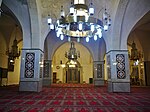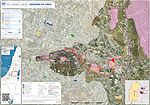Cave of the Patriarchs massacre

The Cave of the Patriarchs massacre, also known as the Ibrahimi Mosque massacre or the Hebron massacre, was a shooting massacre carried out by Baruch Goldstein, an American-Israeli physician and extremist of the far-right ultra-Zionist Kach movement. On 25 February 1994, during the Jewish holiday of Purim, which had overlapped in that year with the Islamic holy month of Ramadan, Goldstein opened fire with an assault rifle on a large gathering of Palestinian Muslims praying in the Ibrahimi Mosque in Hebron. He killed 29 people, several as young as 12 years, and wounded 125. Goldstein was overpowered and beaten to death by survivors. The atrocity strained the Israeli-Palestinian Oslo Accords peace process, immediately setting off mass protests by Palestinians throughout the West Bank. During the ensuing clashes, a further 20 to 26 Palestinians were killed while 120 were injured in confrontations with the Israeli military, and 9 Israeli Jews were also killed.Goldstein was widely denounced in Israel and by communities in the Jewish diaspora, with many attributing his act to insanity. Israeli prime minister Yitzhak Rabin condemned the attack, describing Goldstein as a "degenerate murderer" and "a shame on Zionism and an embarrassment to Judaism". Some Jewish settlers in Hebron lauded him as a hero, viewing his attack as a pre-emptive strike and his subsequent death as an act of martyrdom. Following statements in support of Goldstein's actions, the Jewish ultranationalist Kach party was banned and designated a terrorist organization by the Israeli government.
Excerpt from the Wikipedia article Cave of the Patriarchs massacre (License: CC BY-SA 3.0, Authors, Images).Cave of the Patriarchs massacre
Shapira Gate, Hebron Avraham Avinu Neighborhood
Geographical coordinates (GPS) Address Nearby Places Show on map
Geographical coordinates (GPS)
| Latitude | Longitude |
|---|---|
| N 31.5243 ° | E 35.1118 ° |
Address
البلدة القديمة في الخليل
Shapira Gate
150 Hebron, Avraham Avinu Neighborhood
Judea and Samaria, Palestinian Territories
Open on Google Maps









